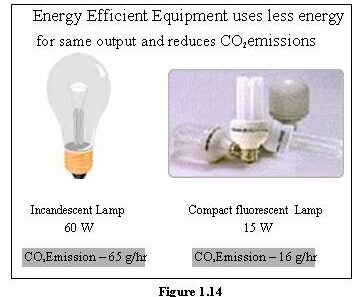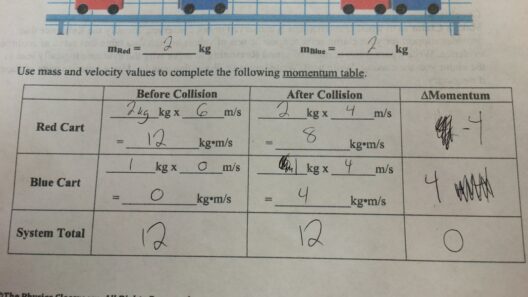Understanding the intricacies of energy dynamics in physical phenomena reveals profound insights into the nature of collisions. Among various types of collisions, inelastic collisions stand out not only for their tangible consequences but also for the enigmatic aspects of energy conservation. The concept that kinetic energy is not conserved in these instances invites a deeper exploration into the transformation of energy, prompting questions that bridge physics and philosophy.
In scenarios where objects collide and subsequently move together, a pivotal transformation occurs: kinetic energy is converted into other forms of energy. The mechanics behind this shift warrants scrutiny. How does kinetic energy dissipate, and what implications does this have for our understanding of energy transfer?
The fundamental distinction between elastic and inelastic collisions serves as a backdrop for this discourse. In elastic collisions, both momentum and kinetic energy are conserved; particles rebound without any loss of energy. Conversely, inelastic collisions, characterized by a degree of deformation, epitomize the fascinating phenomenon where kinetic energy is transformed, often into heat, sound, or internal energy. It is within this transformative process that we encounter the essence of inelastic behavior.
When two objects collide inelastically, the initial kinetic energy is partitioned. Part of it is absorbed in deformation, while another portion might convert to thermal energy due to friction. This transformation can be understood through the lens of energy dissipation. The clashing entities might crunch, crumple, or even stick together. The fascinating aspect here is that while momentum, as dictated by the law of conservation, remains intact, kinetic energy takes a different trajectory.
Visualize a car crash. The kinetic energy of the moving vehicle is a considerable force; yet, upon impact, most of that energy is not conserved within the system. The chaos of twisted metal and shattered glass is a testament to energy dissipation. The sound of the collision and the heat generated are manifestations of this energetic metamorphosis. Energy is never lost; instead, it is merely redistributed into various forms, often rendering it less useful for the original motion context.
Energy Transformation: A Dance of Physics
Examining this phenomenon through the principle of energy transformation amplifies our understanding. Energy does not vanish. Rather, it transitions. Inelastic collisions demonstrate the transition of kinetic energy into potential forms—specifically thermal and mechanical energies. This often entails a complex interplay of the following:
- **Deformation and Internal Energy**: When two objects collide, their structural integrity is tested. The forces exerted in a collision may lead to permanent deformation. The energy absorbed in bending, breaking, or compressing materials converts kinetic energy into elastic potential energy, internal energy, or thermal energy, hence not conserving kinetic energy.
- **Thermal Energy and Friction**: The impact generates heat, a result of friction forces at play when surfaces collide. The kinetic energy expended in this frictional interaction generates thermal energy, fostering an increase in temperature of the colliding bodies. This dissipative effect reveals the lose of kinetic energy in favor of thermal energy.
- **Auditory Energy**: The sound produced during a collision is another captivating aspect of energy transformation. What escapes in kinetic energy translates into acoustic energy. Sounds, vibrations, and resonance all serve as notable evidence of energy conversion, stemming from the initial kinetic forces involved.
Implications on Everyday Life and Engineering
The principles governing kinetic energy conservation extend far beyond theoretical physics; they permeate our daily lives and drive advancements in engineering. In mechanical systems, understanding how to manage inelastic behaviors can lead to innovations in safety features. Consider the integration of crumple zones in vehicles—these designed areas absorb kinetic energy upon impact, converting it into other energy forms, thereby safeguarding passengers. Such engineering marvels prioritize human safety by embracing the very nature of energy transformation.
Furthermore, amusement park rides exploit these principles magnificently. The thrill of a roller coaster is not solely the descent; it lies instead in the careful design to harness energy transformations, controlling momentum and kinetic energy throughout the ride. Understanding the non-conservation of kinetic energy in the context of forces and potential energy allows for exciting experiences designed with safety parameters in focus.
In exploring kinetic energy conservation amidst inelastic collisions, one can appreciate the marvel of energy dynamics. The phenomenon portrays a lesson of transformation rather than loss. By examining the fascinating interplay between kinetic energy and its alternative forms, we garner a more profound respect for the intricacies of the physical world.
This understanding also illustrates how energy is interwoven into the fabric of our universe. As we delve further into the transformation inherent in inelastic collisions, we grasp the allure of this topic—a celebration of the magnificence and complexity of nature at work, continually shifting, transforming, and perpetually intriguing.








